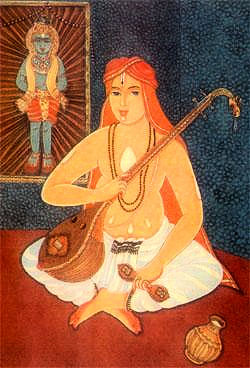

Kompiliert von Alois Payer
Zitierweise | cite as:
Payer, Alois <1944 - >: Musikalische Formen. -- 4. Tanzmusik. -- (Materialien zur karnatischen Musik ; 5.4). -- Fassung vom 2017-03-29. -- URL: http://www.payer.de/karnatischemusik/karnatisch054.htm
Erstmals veröffentlicht: 2009-05-05
Überarbeitungen: 2017-03-29 [Ergänzungen] ; 2009-05-22 [Ergänzungen] ; 2009-05-13 [Ergänzungen]
©opyright: Creative Commons Licence (by, no commercial use)
Dieser Text ist Teil der Abteilung Sanskrit von Tüpfli's Global Village Library
| "At the present day,
however, it is absolutely impossible for anyone to gather an
accurate knowledge of the principles of Hindu music without the aid
of learned natives, a practical acquaintance with the capabilities
of their instruments, and without consulting the best living
performers—things that few persons have opportunity or leisure to
attempt." Day, C. R. (Charles Russell) <1860-1900>: The music and musical instruments of southern India and the Deccan. -- London & New York : Novello, 1891. -- xvi, 173 S. : Ill. ; 25cm. -- S. 7 |
Bei allen Übertragungen von indischer Notation in westliche Notation habe ich willkürlich sa = c1 gesetzt. Da sa, ri usw. Tonstufen und keine festen Tonhöhen bezeichnen, sind die Transskriptionen je nach Stimmlage beliebig transponierbar.
Die elektronisch erstellten midi-Dateien sollen nur einen ersten Eindruck vom Melodieverlauf geben, sie können aber keinen rechten Eindruck von den Musikstücken geben. Dazu höre man Aufnahmen oder Konzerte von indischen Berufsmusikern.
Gute Aufnahmen karnatischer Musik findet man auf Spotify: https://www.spotify.com/de/. -- Zugriff am 2017-03-26
Eine gute Quelle, kostenlos karnatische Musik zu hören ist z.B. http://www.kannadaaudio.com. -- Zugriff am 2009-04-29
Die Taktangaben bei den Transkriptionen dienen NUR dem einfacheren Zählen, geben aber keine direkte Entsprechung zu den Tāla wieder (die ersten (Teil-)Schläge im Tāla sind durch Akzentzeichen gekennzeichnet).
Für die Notierungen gilt, was Bálint Sárosi zur Notierung von ungarischer Volksmusik sagt:
| "In einer Melodie, die wir mit zwei bis
drei verschiedenen Tönen notieren würden, kommt in Wirklichkeit ein
Vielfaches dessen vor." Sárosi, Bálint: Volksmusik : das ungarische Erbe. -- Budapest : Corvina, 1990. -- S. 31 |
Allgemein gilt:
| "Das Problem ist bekanntlich
allgemeiner Natur: Zwischen Notenbild und zu realisierendem
Klang klafft bei jeder Art von Musik eine Lücke, die durch eine
je spezifische, kulturell tradierte Aufführungs- und
Interpretationspraxis ausgefüllt wird. Das Umsetzungsproblem ist
dabei um so gravierender, je historisch älter oder
kulturgeographisch entfernter die jeweilige Musik ist." Bernhard-Friedrich Schulze ; Ehrenhard Skiera: Guitarra flamenca. -- In: Flamenco : gitano-andaluz / hrsg. von Claus Schreiner. -- Frankfurt am Main : Fischer-Taschenbuch-Verlag, 1985. -- (Fischer ; 2994). -- ISBN 3-596-22994-4. -- S. 143 |
Die Sangeet Natak Akademi (संगीत नाटक अकादेमी, The National Academy for Music, Dance and Drama) anerkennt folgende südindischen Tanzstile als klassisch:
Beispiel einer vollständigen Bharatanāṭyam-Aufführung, Album, gesungen von Nandini Sharma, auf Spotify:
URI: spotify:album:43r2OU6rUaH0lJcCB0nloA
URL: https://open.spotify.com/album/43r2OU6rUaH0lJcCB0nloA
Beispiel eines Kuchipuḍi Raṅgapraveśa, Album von Padma, auf Spotify:
URI: spotify:album:4gwkAhqQ2SMaOWkxKvOvcf
URL: https://open.spotify.com/album/4gwkAhqQ2SMaOWkxKvOvcf
Beispiel für Mōhiniyāṭṭam, Album von Trichur Janardanan, auf Spotify:
URI: spotify:track:1yc5FT6qjzm5RUKnY0VMRN
URL: https://open.spotify.com/track/1yc5FT6qjzm5RUKnY0VMRN
Beispiel für Kathakaḷi, Alben von Kalamandalam Sankaram Embranthiri u.a., auf Spotify
URI:
- spotify:album:0xfgJlL43KuJJjORkCt9xT
- spotify:album:5ovQmZJpQQnGzrUWcTg8xI
- spotify:album:5wEN1vZUBDvniuzlibDtIQ
URL:
Daneben gibt es aber zahlreiche regionale Tanzstile:
Album mit Yakṣagāna auf Spotify:
URI: spotify:album:07fuKFcPyymerCfVz2heTV
URL: https://open.spotify.com/album/07fuKFcPyymerCfVz2heTV
Eine kurze Beschreibung all dieser Formen findet man in:
Kersenboom, Sakia ; Natavar, Mekhala Devi: Music and dance : southern area. -- In: The Garland encyclopedia of world music. -- Vol. 5: South Asia : the Indian subcontinent. -- New York [u.a.] : Garland, 2000. -- S. 507 - 523.
Eine deutschsprachige Übersicht über indische Tanzstile ist:
Rebling, Eberhard : Die Tanzkunst Indiens. -- Berlin <Ost> : Henschelverlag Kunst u. Gesellschaft, 1981. -- 263 S. : Ill. . ; 23 cm
Zu Bhārata Nāṭyam:
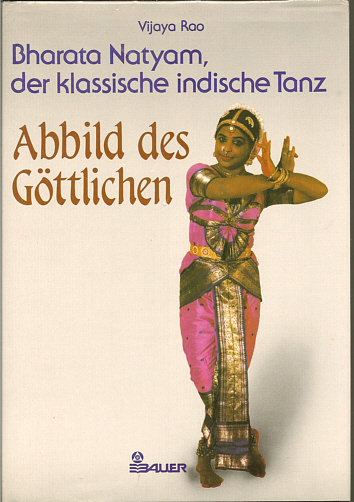
Abb.: Umschlagtitel
Rao, Vijaya <1948 - >: Abbild des Göttlichen : Bharata Natyam - der klassische indische Tanz. -- Freiburg i. Br. : Bauer, 1987. -- 231 S. : Ill. ; 26 cm. -- ISBN 3-7626-0316-2
Zur Musik des Bhārata Nāṭyam in der Tradition von T. Bālasarasvati (1918 - 1984), Enkelin von Vīṇā Dhanammāl (வீணை தனம்மாள்) (1868 - 1938):
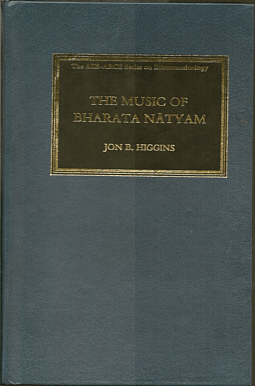
Abb.: Einbandtitel
Higgins, Jon B. <1939 - 1984>: The music of Bharata Nāṭyam. -- Sittingbourne : Asia Publ. House, 1994. -- XXIII, 391 S. : Ill. ; 24 cm. -- (The AIIS-ARCE series on ethnomusicology). -- ISBN 0-948724-37-4
Man unterscheidet:
Im Folgenden geht es nicht um den Tanz als solchen, sondern um die Tanzmusik.
Beim Tanz unterscheidet man:
Die klassische Abfolge (मार्ग = mārga) eines Tanzprogramms wurde von Ponnayya (பொண்ணைய்யா) (1804-1864) (Tanjore Quartett) eingeführt. Sie besteht aus folgenden sieben Hauptteilen:
Darauf folgt das Maṅgala.
Jon B. Higgins charakterisiert in seiner grundlegenden Studie die einzelnen Teile so:
"1.
Alārippu - a brief invocation in pure-dance, with little or
no musical accompaniment. The dance master (naṭṭuvanār),
usually the dancer's teacher, recites a fixed composition of
mnemonic syllables (śolkaṭṭus) which rhythmically
approximate the dancer's choreographed movements.1
2. Jatisvaram - a musical composition without sāhitya, the melody becoming progressively more complex rhythmically. The piece is sung in svaras (solfège syllables) and the dance is choreographed so as to display the dancer's brisk footwork, rhythmic coordination and physical grace. 3. Śabdam - introduces four lines of poetic text upon which the singer weaves a series of melodic improvisations. The item is set in miśra cāpu tāla (seven counts) and traditionally in Kṃmbhoji rāga. Today a rāgamālikā ("garland of (four) rāgas") commencing with Kāmbhoji, is often used. The dancer performs mainly nṛtya. 4 Padavarṇam - commonly referred to these days as the pièce de résistance of a Bharata Nāṭya performance. All aspects of the dance are found in this piece; nṛtta notably the most rhythmically difficult pieces called tirmānams, alternates with nṛtya in a constantly shifting but purposeful exposition of the dancer's technique and imagination. This item sometimes lasts for more than an hour. A brief intermission follows this piece. 5. Padams and Jāvalis - calm the hectic pace. A series of romantic-philosophical songs of great lyric power allow the dancer to give leisurely expression to her talents in abhinaya, as she depicts the lovelorn nāyikā in a variety of moods and amorous predicaments. The Jāvali is usually shorter than the padam, somewhat more erotic in flavor, and composed in rāgas which admit considerable flexibility in the exposition. 6. Tillāna - designed to introduce variety and rhythmic excitement into the latter portion of the program. This is musically a very simple piece utilizing drum śolkaṭṭus in the text, against which the dancer executes a series of complex rhythmic variations in pure-dance. On rare occasions of few simple lines of text may also be added.7. Śloka - a highly concentrated form of Sanskrit verse to which the musicians improvise rāga phrases in free rhythm while the dancer enacts her own interpretation of the text in abhinaya. These ślokas (sometimes replaced by the Tamil viruttam or Telugu sīsapadya) are very old, and it is safe to assume that they too were included in the Quartet's format." Higgins, Jon B. <1939 - 1984>: The music of Bharata Nāṭyam. -- Sittingbourne : Asia Publ. House, 1994. -- XXIII, 391 S. : Ill. ; 24 cm. -- (The AIIS-ARCE series on ethnomusicology). -- ISBN 0-948724-37-4. -- S. 19f. |
Beispiel einer vollständigen Bharatanāṭyam-Aufführung auf Spotify:
Album, gesungen von Nandini Sharma, auf Spotify:
URI: spotify:album:43r2OU6rUaH0lJcCB0nloA
URL: https://open.spotify.com/album/43r2OU6rUaH0lJcCB0nloA
So man für den Gesang die Jāti's sa-ri-ga-ma-pa-da-ni hat und der Rhythmus die Jati/Solkaṭṭu ta-ka-dhi-mi usw. hat man für den Tanzrhythmus Jati's (ஜதி):
z.B. für Tattāḍavu (eine Grundfigur / Tanzeinheit - aḍavu = அடவு - von Bhāratanāṭyam) in Rūpaka-tāla (O |4) folgende:
| O | |4 | ||||
|---|---|---|---|---|---|
| Tai | Tai | Tai | Tai | Dhit Dhit | Tai |
| Tai | Tai | Tai | Tai | Ta Ka Dhi Mi | Ta Ka Jho Nu |
Tattāḍavu, von Gajendhran, auf Spotify:
URI: spotify:track:1ViksU6nCzXJJ65AW0huE1
URL: https://open.spotify.com/track/1ViksU6nCzXJJ65AW0huE1
Beispiel für aḍavu, Album von Gajendhran, auf Spotify:
URI: spotify:album:1odfXH5gx3l6juG1FSVOHc
URL: https://open.spotify.com/album/1odfXH5gx3l6juG1FSVOHc
Musikalischer Leiter einer Tanzaufführung ist der Nattuvānar, idealerweise der Guru der Tänzerin oder des Tänzers. Er "dirigiert" Tänzer und Musiker mit dem Nattuvāngam (நட்டுவாங்கம்), einem Paar kleiner Zimbeln.
Das Musikensemble (pakka vādya / பக்கவாத்தியம்) für Bhārata Nāṭyam besteht aus:
Nattuvānar
einem Sänger / Sängerin
ein Mṛdāṅga-Spieler
einem Violin-Spieler und/oder einem und/oder einem Vīṇā-Spieler
Die Musiker sind immer auf der rechten Seite der Tänzerin platziert, d.h. vom Zuschauer aus gesehen links.
Siehe auch den Exkurs:
Devadāsī / Thurston, Edgar <1855-1935> ; Rangachari, K.: Castes and tribes of southern India, 1909. -- Fassung vom 2009-05-20. -- URL: http://www.payer.de/karnatischemusik/karnatisch0541.htm
Der eigentlichen Tanzvorstellung geht das Lob von Gottheiten voran. Manche Tänzerinnen des Bhārata Nāṭyam haben dazu Kavuttuvam (siehe hier) ins Bühnenprogramm aufgenommen, andere halten dies eher für eine Profanierung und vollziehen statt dessen Puṣpāñjali (Darbringung von Blumen).
| "This invocatory exercise is an
epitome of all the important poses and movements." Sambamoorthy, P. <1901 - 1973>: South Indian music. -- Book IV. -- Reprint of the 8th ed., 1998 -- Chennai : Indian Music Publishing House, 2007. -- S. 200. |
Einleitendes Stück einer Tanzvorführung. Dient der Entfaltung der aḍavu (Grundfiguren / Tanzeinheiten), ist also reiner, nicht erzählender Tanz (nṛtta). Die musikalische Begleitung erfolgt auf keinen sinnvollen Text, sondern auf Silben (Jati / ஜதி oder solkaṭṭu).
Beispiele für Alārippu auf Spotify
von Malati Iyengar u.a.:
URI: spotify:track:7JN8gwm9OwGjm1WYd9Brh0
URL: https://open.spotify.com/track/7JN8gwm9OwGjm1WYd9Brh0von Malati Iyengar u.a.:
URI: spotify:track:1FBi2w0Dod6CSsKwQ56Vrs
URL: https://open.spotify.com/track/1FBi2w0Dod6CSsKwQ56Vrsvon Bhuvana Ravi und Balameera Chandra:
URI: spotify:track:7xvyfVTH74lKtsEzlWDT2A
URL: https://open.spotify.com/track/7xvyfVTH74lKtsEzlWDT2Avon Nandini Sharma:
URI: spotify:track:7BlD4gD95zxwDdbiZ0qypP
URL: https://open.spotify.com/track/7BlD4gD95zxwDdbiZ0qypP
Abwechselnd melodische und stark rhythmische Musik auf Silben ohne sinnvollen Text. Dient dem reinen Tanz (nṛtta). Besteht aus Pallavi und Caraṇa's.
Beispiele für Jatisvaram auf Spotify:
von Bhuvana Ravi und Balameera Chandra:
URI: spotify:track:5CI36e7vHh5UJ6kILLJQn0
URL: https://open.spotify.com/track/5CI36e7vHh5UJ6kILLJQn0von Bhuvana Ravi und Balameera Chandra:
URI: spotify:track:3pkdxbYEJBZlctuLMIyJ7Y
URL: https://open.spotify.com/track/3pkdxbYEJBZlctuLMIyJ7Yvon Vamana Namboodiri und Kalamandalam Jaya Prakash:
URI: spotify:track:5eGJpmyHwSX7olcmeyHVOP
URL: https://open.spotify.com/track/5eGJpmyHwSX7olcmeyHVOPvon Srekala Bharath:
URI: spotify:track:6PShTTZx2iy2MRGoIX7SzW
URL: https://open.spotify.com/track/6PShTTZx2iy2MRGoIX7SzWvon Bala Sarasvati u.a.:
URI: spotify:track:7CYiTtiXzvMgydIqDfrFzf
URL: https://open.spotify.com/track/7CYiTtiXzvMgydIqDfrFzf
Tänzerische Interpretation eines kurzen Gedichts religiösen Inhalts. Reiner Tanz (nṛtta) und Ausdruckstanz (abhinaya). Śabda ist meist in Rāga Harikāmbhojī (Meḷa 28) und Cāpu Tāla. Im Unterschied zum Varṇa werden die rhythmischen Silben vom Sänger auf eine Melodie gesungen.
| "Whenever dancers were invited to
perform before Maharajahs, Zamindars and Nobles, the artistes
invariably took with them a new Sabdam composed in honour of
the patron and executed dance for that composition before him. Since
the Sabdam was concluded with salām i.e. salutation,
the composition itself came to be called salāmu." Sambamoorthy, P. <1901 - 1973>: South Indian music. -- Book IV. -- Reprint of the 8th ed., 1998 -- Chennai : Indian Music Publishing House, 2007. -- S. 201. |
Beispiele für Śabdam auf Spotify:
gesungen von Padma Chebrolu:
URI: spotify:track:6iD7kCZVMhe8ABm1hU8QJZ
URL: https://open.spotify.com/track/6iD7kCZVMhe8ABm1hU8QJZgesungen von Nandini Sharma:
URI: spotify:track:01hksWl2iIsL7vSQ9JA3gg
URL: https://open.spotify.com/track/01hksWl2iIsL7vSQ9JA3gg
Siehe: Abhyāsagāna = Übungsstücke
Im Unterschied zum Śabdam werden die rhythmischen Silben nicht gesungen, sondern vom Nattuvānar rezitiert.
Beispiele von Varṇam auf Spotify
2 Alben von Madurai R. Muralidaran auf Spotify:
URI:URL:
Beispiele: Bhagyalekshmy, S., Part 4, S. 9 - 31
Padam hat als Thema Bhakti (hingebende Gottes-Liebe), die dargestellt wird durch das Verhältnis von Nāyaka und Nāyikā = irdischem Liebhaber und Geliebter. Als dritte Person fungiert die Sakhī, die Freundin. Diese drei Personen haben eine metaphysisch-metaphorische Bedeutung. Vorwiegend Ausdruckstanz (abhinaya).
| "When
abhinaya is performed for a padam, the Nattuvānar (dance master)
will be found to be singing a passage over and over again. But a
careful observation of the gestures of the dancer will reveal the
fact that she is trying to communicate to the audience in
succession, the several meanings that the passage admits of." Sambamoorthy, P. <1901 - 1973>: South Indian music. -- Book IV. -- Reprint of the 8th ed., 1998 -- Chennai : Indian Music Publishing House, 2007. -- S. 202. |
Als Vater der musikalische Form Pada gilt Kṣetrajña (క్షేత్రయ్య) (ca 1600 - 1680 n. Chr.).
Als Vorläufer dieser Form kann man die aṣṭapadī-Tanzlieder im Gītagovinda des Jayadeva (ca. 13. Jhdt.) ansehen. Man glaubt, dass Kṣetrajña eine Wiedergeburt Jayadevas ist.
aṣṭapadī-Album, von R. Vedavalli und B. Krishnamoorthy, auf Spotify:
URI: spotify:album:7uVp67epIP6kSaqm7YmDJy
URL: https://open.spotify.com/album/7uVp67epIP6kSaqm7YmDJy
Wichtige Pada-Dichterkomponisten sind u.a.:
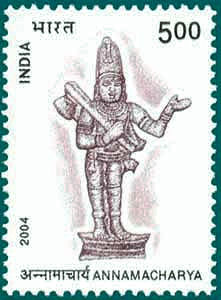
Abb.: Annamacharya
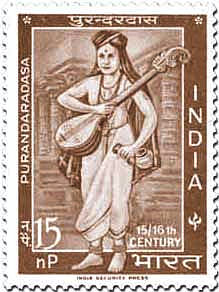
Abb.: Purandaradāsa
Muttutāṇḍavar (1560? - 1640?) (முத்துத் தாண்டவர்)
Kancherla Gopanna (ca. 1620 - 1680) = Bhadradri Ramadasu = Bhadrachala Ramadasu (భద్రాచల రామదాసు)
Sarangapani (17. Jhdt.)
Künstlerlink auf Spotify:
URI:
spotify:artist:5ucLsWIUeOI5ckTdQpFZXR
URL:
https://open.spotify.com/artist/5ucLsWIUeOI5ckTdQpFZXR
Arunācalakkavirayar (1711/12 - 1788) (அருணாசல கவி)
Marimutthu Pillai (?1717 - ?1787) (மாரிமுத்துப் பிள்ளை)
Ghanam Krishna Iyar (1790-1854)
Chinnaya / Ciṉṉiah = Ciṉṉayya (1803 - )
Muvvānallūr Sabhāpati Ayyar (frühes 19. Jhdt.)
Kavikuñjara Bhārati (1810-1896) (கவிகுஞ்சர பாரதியார்)
Gopālakṛṣṇa Bhārati (கோபாலகிருஷ்ண
பாரதி) (1811 - 1896)
Künstlerlink auf Spotify:
URI:
spotify:artist:1nxTVTUnplm2G0j1Vn6T7N
URL:
https://open.spotify.com/artist/1nxTVTUnplm2G0j1Vn6T7N
Svāti Tirunāḷ Mahārāja (ശ്രീ
സ്വാതി തിരുനാള് രാമ വര്മ്മ) (1813 - 1846)
Künstlerlink auf Spotify:
URI:
spotify:artist:1dmZ1yRs52XY89a4dO9ir3
URL:
https://open.spotify.com/artist/1dmZ1yRs52XY89a4dO9ir3
Tarangampadi Panchanada Ayyar (1824-1874)
Madurai N.Krishnan (1928 - )
Künstlerlink auf Spotify:
URI:
spotify:artist:5fPlqDKU8Ndv0K9C0mJXwq
URL:
https://open.spotify.com/artist/5fPlqDKU8Ndv0K9C0mJXwq
Beispiel: aligitē bhagya māye
Tāla: tripuṭa |3 O O (3 + 2 + 2)
Rāga: Husēni: janya-saṃpūrṇa-saṃpūrṇa-upāṅga-vakra zu Meḷa 22: Kharaharapriya
Abb.: Tonmaterial von Kharaharapriya

Abb.: Tonleiter von Husēni
Dichterkomponist (vāggeyakāra): Kṣetrajña = క్షేత్రయ్య (ca. 1600 - 1680)
Vorlage: Bhagyalekshmy, Heft $, S. 14 - 16
| Pallavi: aligitē bhagya māye marēmi vāḍalagitē bhāgyamāye |
Pallavi: Even if Muvva Gopala is annoyed with me, I am happy. |
| Anupallavi: taliru bōṇirō vāni danḍinca galana vā |
Anupallavi: Oh my dear lady, am I capable of punishing him? |
| Caraṇa 1:
ara sompu māṭa lāḍē vānikinē |
Caraṇa 1: He doesn't speak wholeheartedly. Can I ever become his favorite? Oh my dear friend, he doesn't come closer to see my face. I just keep my faith in God. |
| Caraṇa 2:
bāḷi lēdika nā pondu |
Caraṇa 2: He seems to be fed up with my company. Oh my lady with black tresses, he is not bothered of my well being. He is pitiless. |
| Caraṇa 3:
bāla prāyamu nāḍe bhramiyinci nannu vā |
Caraṇa 3: From my very young days, I am enticed by his pleasing words. He promised so many things to me. Oh my young lady, Muvva Gopala is now annoyed with me. |
| Übersetzung des Telugu-Textes von: http://www.sangeetasudha.org/othercomposers/kshetrayya.html. -- Zugriff am 2009-04-30 |
1. Pallavi:
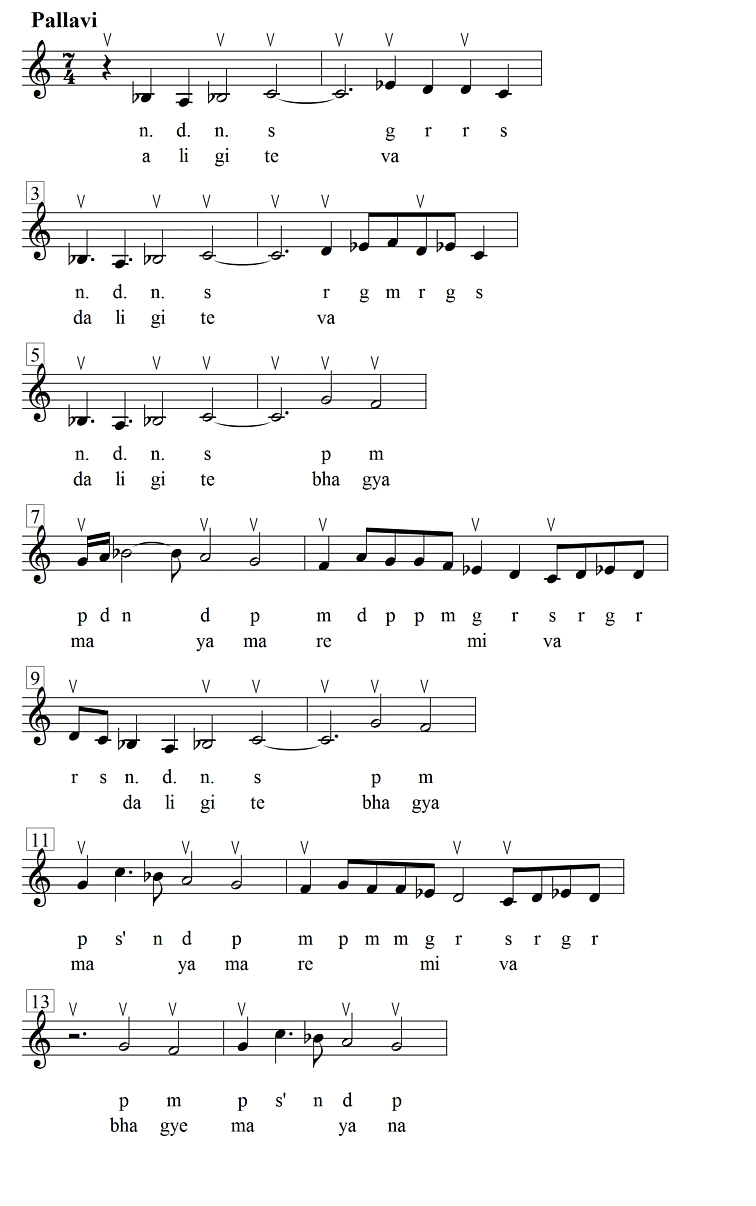
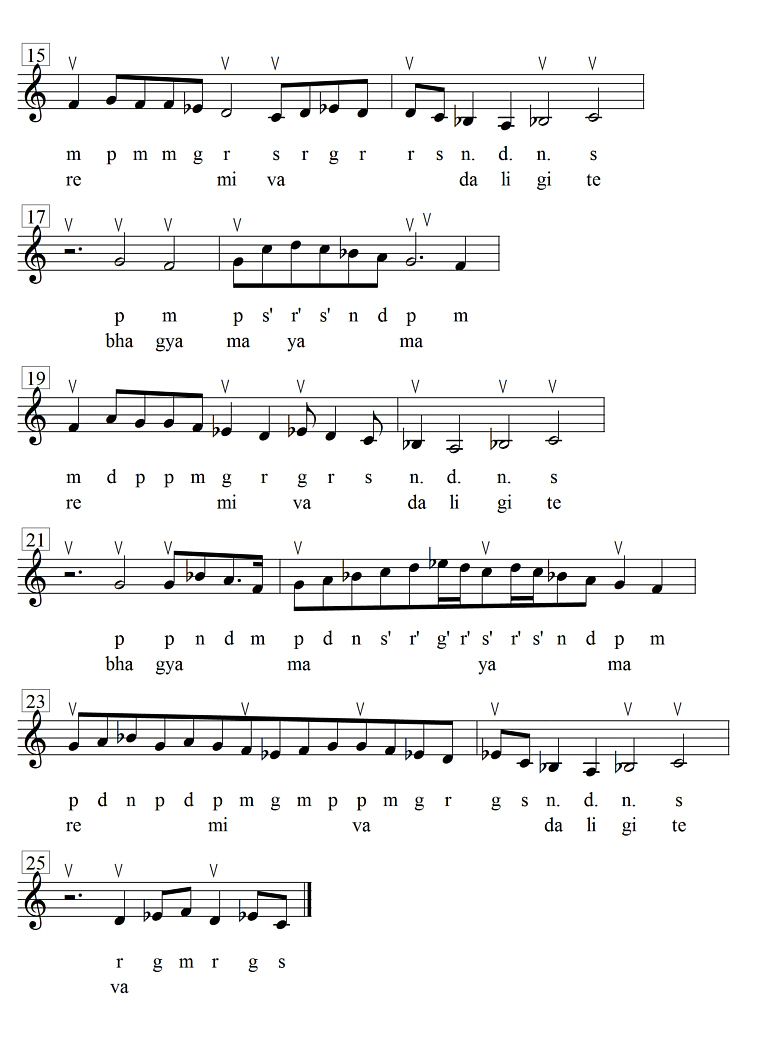
Abb.: aligitē bhagya
māye, Pallavi
2. Anupallavi:
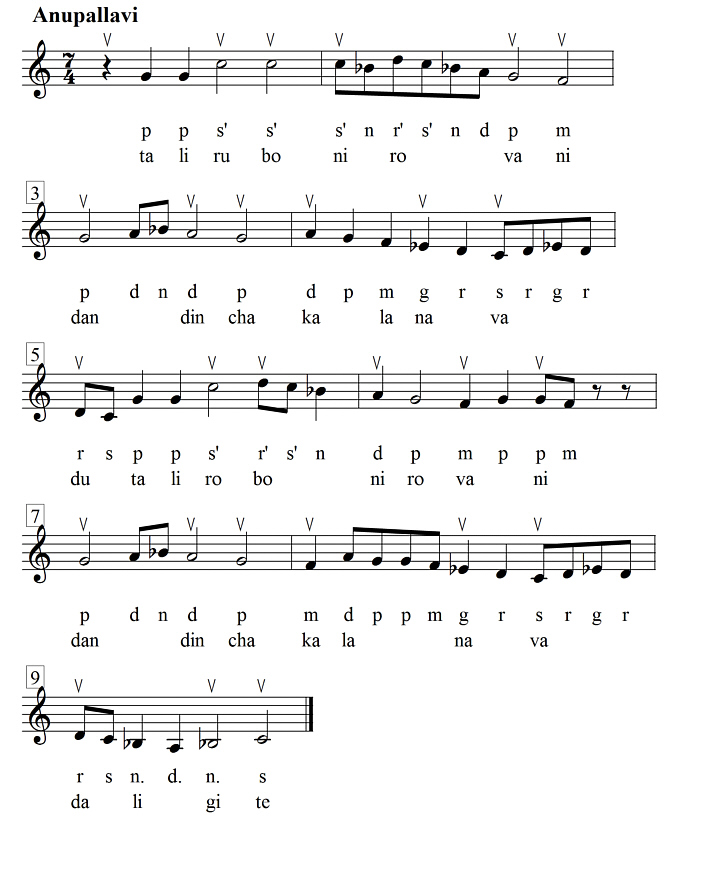
Abb.: aligitē bhagya māye, Anupallavi
3. Caraṇa:
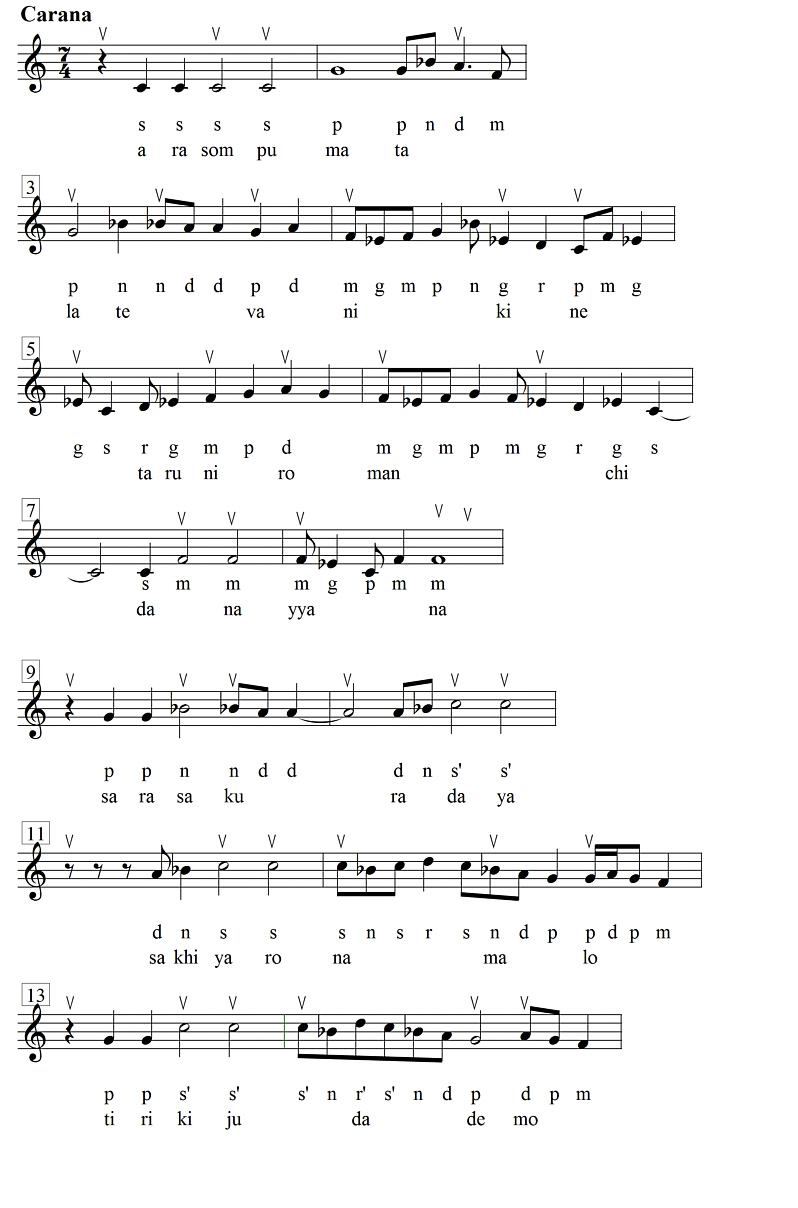

Abb.: aligitē bhagya māye, Caraṇa
Beispiele: Bhagyalekshmy, S., Part 4, S. 32 - 39
Jāvaḷi ist eine dem Pada ähnliche Form, die erst im 19. Jahrhundert populär wurde. Gegenstand ist die erotische Liebe, dargestellt durch Liebhaber, Geliebte und Freundin (Nāyaka, Nāyikā, Sakhī). Jāvaḷi haben als Sätze Pallavi, Anupallavi und 3 bis 4 Caraṇa. Die Sprache des Textes (sāhitya) ist einfache Regionalsprache. Dient vorwiegend dem Ausdruckstanz (abhinaya).
Beispiele für Jāvaḷi auf Spotify:
gesungen von Nandini Sharma:
URI: spotify:track:0BmBrayMTQ53YI6CeEC0ol
URL: https://open.spotify.com/track/0BmBrayMTQ53YI6CeEC0olgesungen von Vijayantimala:
URI: spotify:track:58okQFekkUwf0BSLvqojl0
URL: https://open.spotify.com/track/58okQFekkUwf0BSLvqojl0von Padma Subrahmaniam und Shyamala Balakrishnan:
URI: spotify:track:2MXC7wb9wTrtnepuF4Sbey
URL: https://open.spotify.com/track/2MXC7wb9wTrtnepuF4Sbey
Wichtige Dichterkomponisten (vāggeyakāra) sind u.a.:
Candrasēkhara Śāstrī (Kōlar Chandrasēkharayya, Bangalore Chandrasēkharayya)
Tañjāvūr (Tanjore) Quartette
Künstlerlink auf Spotify:
URI:
spotify:artist:0Hi3u0FPcVoVy0GSgTX2jZ
URL:
https://open.spotify.com/artist/0Hi3u0FPcVoVy0GSgTX2jZ
Pattabhiramayya
Künstlerlink auf Spotify:
URI:
spotify:artist:6UCF8zquRpRl8f3da56b4S
URL:
https://open.spotify.com/artist/6UCF8zquRpRl8f3da56b4S
Svāti Tirunāḷ Mahārāja (ശ്രീ
സ്വാതി തിരുനാള് രാമ വര്മ്മ) (1813 - 1846)
Künstlerlink auf Spotify:
URI:
spotify:artist:1dmZ1yRs52XY89a4dO9ir3
URL:
https://open.spotify.com/artist/1dmZ1yRs52XY89a4dO9ir3
Beispiel: apadūruku lonai
Tāla: madhyādi (4 + 2 + 2)
Rāga: Khamas: janya-ṣāḍava-saṃpūrṇa-upāṅga-vakra zu Meḷa 28: Harikāmbhojī
Abb.: Tonmaterial von Harikāmbhojī

Abb.: Tonleiter von Khamas
Dichterkomponist: Tiruppanandāḷ Paṭṭābhirāmayya (1863 - )
Vorlage: Bhagyalekshmy, Heft 4, S. 33f.
Der Song auf Spotify:
gesungen von M.L. Vasanthakumari:
URI: spotify:track:1pyaNpODd0sUqFzX8gj06c
URL: https://open.spotify.com/track/1pyaNpODd0sUqFzX8gj06c
von Chitti Babu u.a.:
URI: spotify:track:6Wc9J6LBn9VGJcoTOGfS9L
URL: https://open.spotify.com/track/6Wc9J6LBn9VGJcoTOGfS9L
von Nathamuni Brothers:
URI: spotify:track:0xshotlycCbLzwhsMTHL6Z
URL: https://open.spotify.com/track/0xshotlycCbLzwhsMTHL6Z
gesungen von Nalini Ramprasad:
URI: spotify:track:5mOQyWiAXlyKNyYyt3r2xY
URL: https://open.spotify.com/track/5mOQyWiAXlyKNyYyt3r2xY
| Pallavi:
apadūruku lōnaitinē capala cittamu
cēdanē |
| Anupallavi
ē pāpi nāpai darēnukā ē
pāpamu lēka |
| Caraṇa
1. vēḍukala jūḍanē īdu cēdela tōḍanē
gūḍi atani mēḍakēkidē vāḍu nā celikāḍanē 2. sāreku sāmini dūritini gāni
navvitē jāriṇiyani ūrivāralu vērē pēriḍi nannu pilicerē 3. ciruta natanuṇḍina biruducē
guāavantudau vara tāḷavanē śunitō sarasamāḍusu gūḍitinani |
1. Pallavi
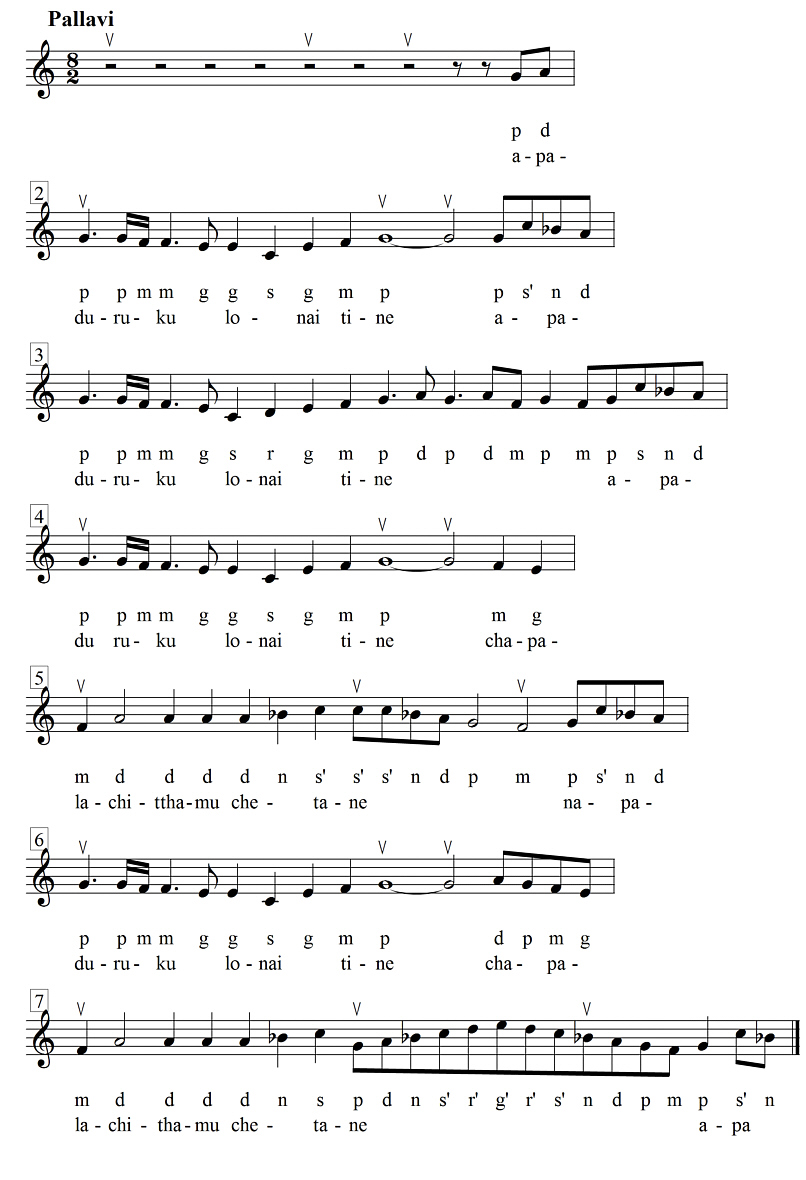
Abb.: apadūruku lonai,
Pallavi
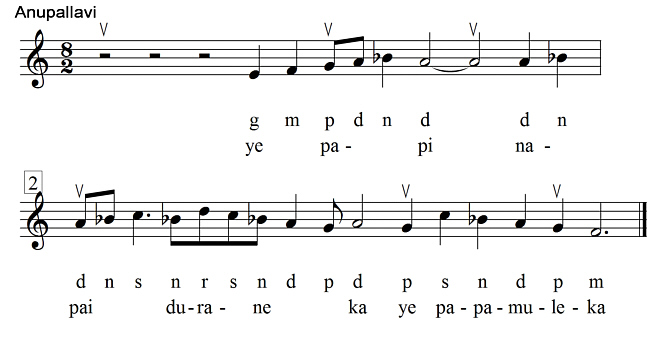
Abb.: apadūruku lonai, Anupallavi
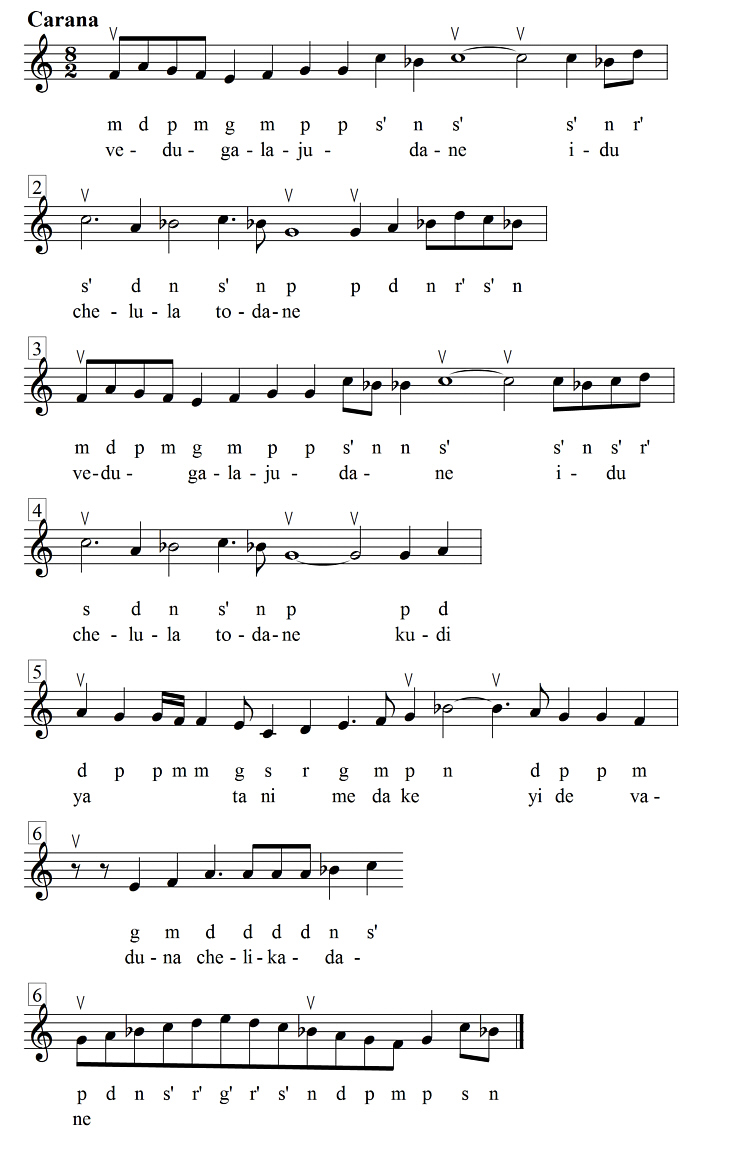
Abb.: apadūruku lonai, Caraṇa
Beispiele: Bhagyalekshmy, S., Part 4, S. 39 - 45
Tillānā sind heute oft das Schlussstück in Konzerten oder Tanzaufführungen. Tillānā haben zwei oder drei Sätze: Pallavi und/oder Anupallavi, Caraṇa. Besonders Tanztillānā enthalten komplizierte rhythmische Silben (jāti), die der Tänzerin Gelegenheit geben, ihr Können zu zeigen. Der Text (sāhitya) ist meist Lob Gottes oder eines Königs oder eines Sponsors. Bei Teilen mit Text Ausdruckstanz (abhinaya), sonst reiner Tanz (nṛtta).
Beispiele für Tillānā auf Spotify:
gesungen von Vijayantimala:
URI: spotify:track:6sAx6Dd5zibZcCgYPE3MzO
URL: https://open.spotify.com/track/6sAx6Dd5zibZcCgYPE3MzOvon S.M. Ramh u.a.:
URI: spotify:track:4Yg5QGhStPzfKvO4ejrFlV
URL: https://open.spotify.com/track/4Yg5QGhStPzfKvO4ejrFlVvon Palghat T.S. Mani Iyer u.a.:
URI: spotify:track:0A4hIWl4ky0lBbNzCjvy8l
URL: https://open.spotify.com/track/0A4hIWl4ky0lBbNzCjvy8lgesungen von Sikkil Gurucharan:
URI: spotify:track:5M2Zo0Hwq4jZ1aDEZaXOTG
URL: https://open.spotify.com/track/5M2Zo0Hwq4jZ1aDEZaXOTG
Wichtige Dichterkomponisten (vāggeyakāra) sind u.a.:
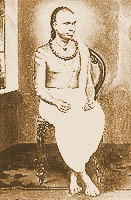
Abb.: Mahāvaidyanātha Śivan
[Bildquelle: Wikipedia. Public domain]
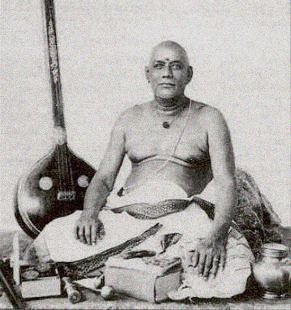
Abb.: Harikēśanallūr
Mutthiah Bhāgavatar
[Bildquelle: Wikipedia. Public domain]
Mangalampalli Bālamuraḷī
Krishna (మంగళంపల్లి బాలమురళీకృష్ణ)
(1930 - )
Künstlerlink auf Spotify:
URI:
spotify:artist:22wOeWBf0MVODTsB32tp6y
URL:
https://open.spotify.com/artist/22wOeWBf0MVODTsB32tp6y
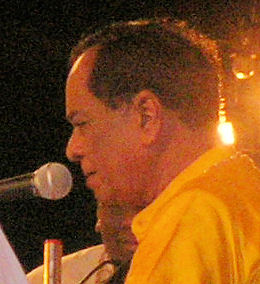
Abb.: M. Bālamuraḷī Krishna
[Bildquelle: Gagan555 / Wikipedia. Public domain]
Lālguḍi Jayarāma Iyer (லால்குடி
ஜயராம ஐயர்) (1930 - )
Künstlerlink auf Spotify:
URI:
spotify:artist:3H1Wru3lkInKnL3yIvnzrF
URL:
https://open.spotify.com/artist/3H1Wru3lkInKnL3yIvnzrF
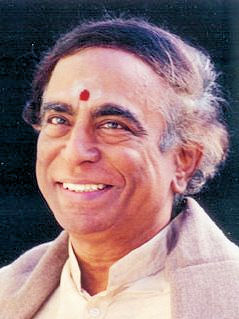
Abb.: Lālguḍi Jayarāma Iyer
[Bildquelle: Edgesused / Wikipedia. Public domain]
Beispiel:
Tāla: ādi |4 O O (4 + 2 + 2)
Rāga: Paras (= Paraju): janya-ṣāḍava-saṃpūrṇa-upāṅga-kram zu Meḷa 15: Māyāmālavagauḷa
Abb.: Tonmaterial von Māyāmālavagauḷa

Abb.: Tonleiter von Paras = Paraju
Komponist: Rāmnād ('Pūcci') Śrinivāsa Ayyaṅgār (1860 - 1919)
Vorlage: Bhagyalekshmy, Heft 4, S. 42 - 47
1. Pallavi:
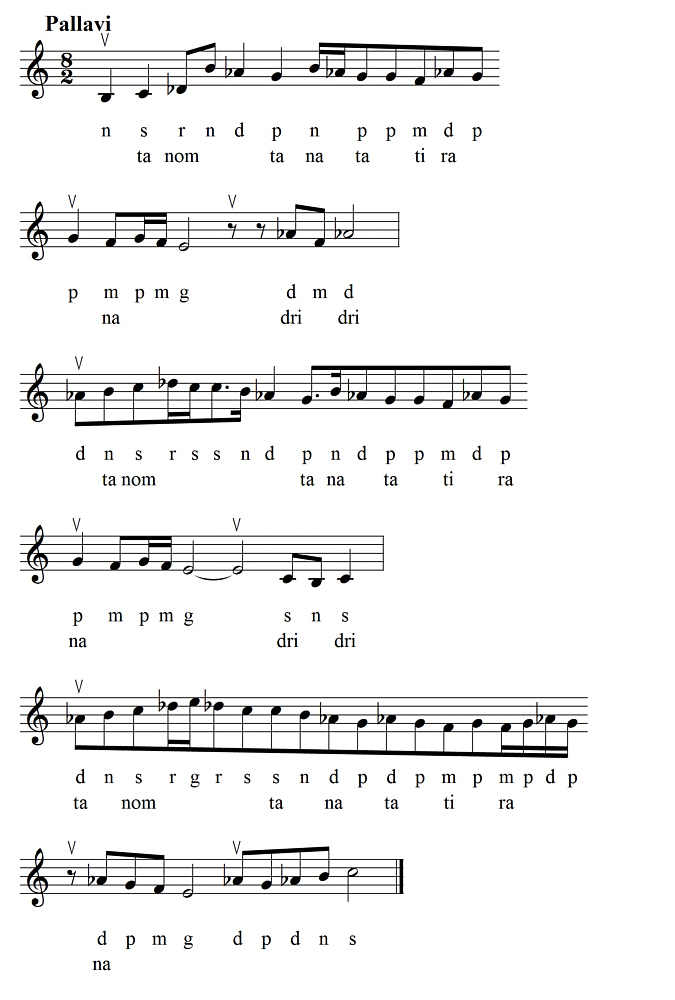
Abb.: Tillānā, Pallavi
2. Anupallavi:
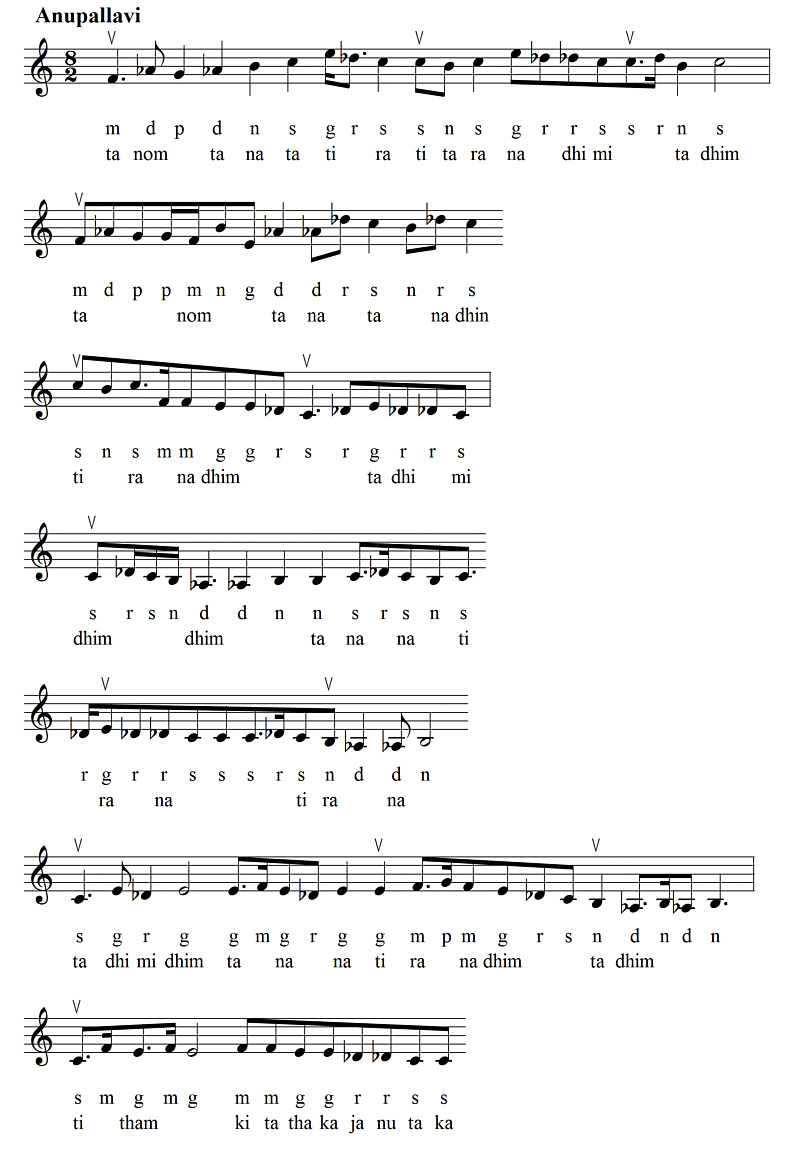

Abb.: Tillānā, Anupallavi
3. Carana:
| rāmanādhapurapalakadau mutthu rāmāliṅga rājendra vibhūni abhi rāmīraya mukha rakhin jhumuvā rāhi rājarājeśvarī sankarī tām takitha ... |
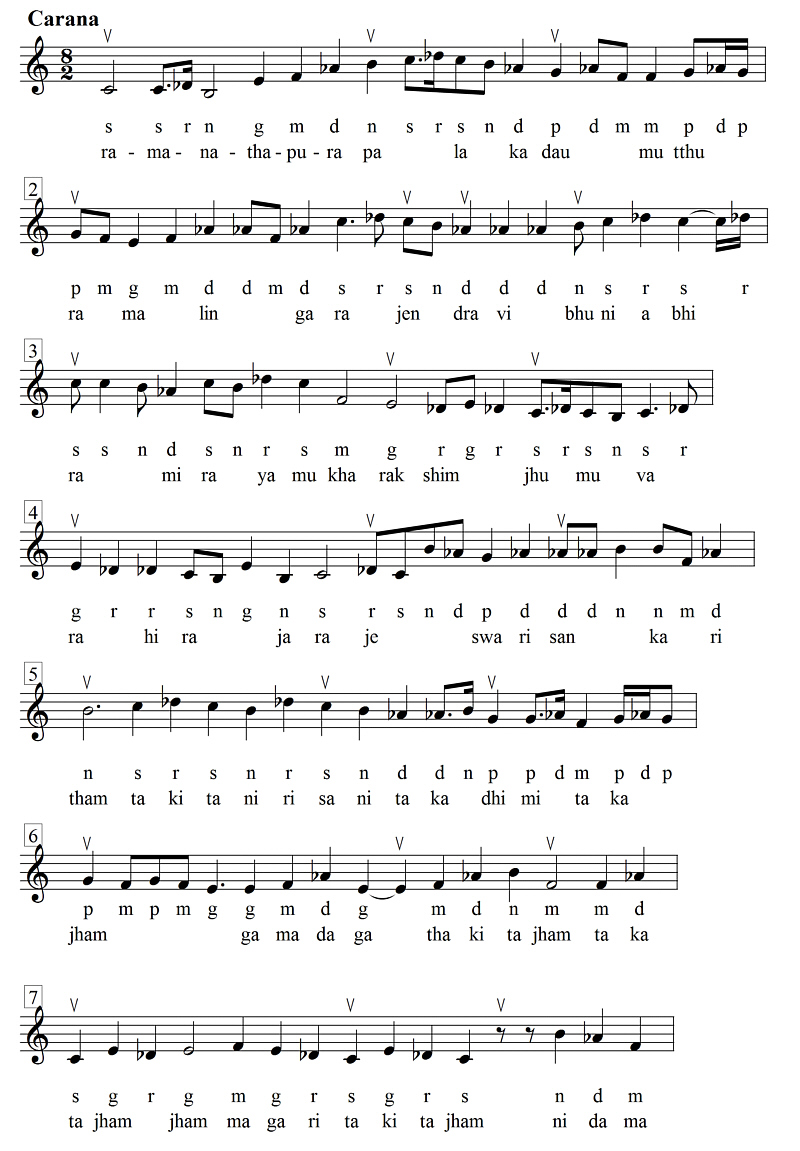

Abb.: Tillānā, Caraṇa
Gesang auf Sanskritverse (śloka) bzw. Tamilverse (viruttam) oder Teluguverse (padyam) ohne bestimmten Tāla mit entsprechendem Ausdruckstanz (abhinaya).
Wurde in Tanzaufführungen vor allem von von M. S. Subbulakshmi (1916 - ) eingeführt.
Künstlerlink auf Spotify:
URI: spotify:artist:35NVYJXOwkjY8bpul6OBQl
URL: https://open.spotify.com/artist/35NVYJXOwkjY8bpul6OBQl
Maṅgala ist ein Glück wünschender und bringender Gesang. Jedes Konzert und jede Tanzaufführung sollte mit einem Maṅgala enden.
Einige beliebte Maṅgala sind:
| Name des Maṅgala | Rāga | Dichterkomponist | Auf Spotify |
|---|---|---|---|
| Nī nāma rūpamulaku | Saurāṣṭra | Tyāgarāja (త్యాగరాజ, தியாகராஜா) (1767 - 1847) | gesungen von O.S. Thyagarajan: URI: spotify:track:50JGuxV5AqHg366drhpqvu URL: https://open.spotify.com/track/50JGuxV5AqHg366drhpqvu |
| Makulamunakiha | Suraṭi | Tyāgarāja | |
| Jayamaṅgalam | Ghaṇṭā | Tyāgarāja | gesungen von Geetha Raja: URI: spotify:track:6H53juicGuHC3CN7S51Gco URL: https://open.spotify.com/track/6H53juicGuHC3CN7S51Gco |
| Jayamaṅgalam | Mohana | Tyāgarāja | |
| Jayaki nayaka niku | Dhanyāsi | Tyāgarāja | |
| Bhavamāna | Saurāṣṭram | Tyāgarāja | gesungen von Trivandrum R.S. Mani: URI: spotify:track:4oGPfBvt5KCUPuZd4uPAyP URL: https://open.spotify.com/track/4oGPfBvt5KCUPuZd4uPAyP |
| Jayamaṅgala | Dhanyāsi | Purandara Dāsa (ಪುರಂದರ ದಾಸ) (1484 - 1564) | |
| Māpāli dēvuniki | Panturavāḷi | Shahji Maharaja (1684 A.D. - 1710 A.D.) | |
| Bhujaga sāyinō | Yadukulakāmbhoji | Svāti Tirunāḷ Mahārāja (ശ്രീ സ്വാതി
തിരുനാള് രാമ വര്മ്മ) (1813 - 1846) |
von Khanda Triputa u.a.: URI: spotify:track:4sGvgrEpCfAuOVb29nZNJ2 URL: https://open.spotify.com/track/4sGvgrEpCfAuOVb29nZNJ2 |
| Śrī Rāmacandranukku | Suraṭi | Arunācalakkavirayar (1711/12 - 1788) | |
| Maṅgalam Śrī Rāmunaku | Vasanta | Mysore Sadāśiva Rao (19. Jhdt.) | |
| Srimat kakarla vamsabdi | Madhyamāvati | Wālājapet Veṅkaṭarāmaṇa Bhāgavatar (1781 - 1874) |
| "Songs of
salutation or hail, called Mangala, are sung at the conclusion of
all performances. Melodies of this kind are usually in either the
rāgas Surati or Saurāshtra. The following is one of the most common
Mangalas. The chief peculiarity in songs of this kind is evident
here—the beats of the tāla falling upon tied notes at the
commencement of a bar.
Day, C. R. (Charles Russell) <1860-1900>: The music and musical instruments of southern India and the Deccan. -- London & New York : Novello, 1891. -- xvi, 173 S. : Ill. ; 25cm. -- S. 85. |
Zu Musikalische Formen 5: Volksmusik und Populärmusik